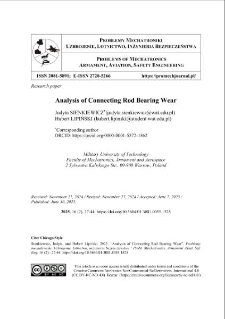Nasza Biblioteka Cyfrowa udostępnia 1 868 obiektów cyfrowych
Obiekt
Tytuł: Analysis of Connecting Rod Bearing Wear ; Analysis of Connecting Rod Bearing Wear
Tytuł odmienny:
Analiza zużycia panewek korbowodowych ; Analiza zużycia panewek korbowodowych
Współtwórca:
Hubert LIPIŃSKI ; Hubert LIPIŃSKI
Abstrakt:
This paper analyses the wear mechanisms occurring in connecting rod bearings, which are exposed to various mechanical failures, such as incorrect assembly, high loads, extreme temperatures, unsuitable operating conditions, or loss of lubrication. The investigation was conducted on previously collected post-service samples, each evaluated for factors contributing to their wear or damage. The samples came from eight engines belonging to two groups – four- and six-cylinder BMW units installed in vehicles produced during the same time period. Advanced research techniques, such as optical microscopy, surface profilometry, and hardness measurements, were employed for the bearing analysis. Several wear mechanisms were identified, including sliding wear, fatigue wear (characterised by visible cracks and material pull-out), surface discolouration, as well as two-body and three-body abrasive wear (evidenced by friction marks). The research enabled a detailed characterisation of bearing wear mechanisms and improved understanding of the factors influencing their durability under various operating conditions.
;
This paper analyses the wear mechanisms occurring in connecting rod bearings, which are exposed to various mechanical failures, such as incorrect assembly, high loads, extreme temperatures, unsuitable operating conditions, or loss of lubrication. The investigation was conducted on previously collected post-service samples, each evaluated for factors contributing to their wear or damage. The samples came from eight engines belonging to two groups – four- and six-cylinder BMW units installed in vehicles produced during the same time period. Advanced research techniques, such as optical microscopy, surface profilometry, and hardness measurements, were employed for the bearing analysis. Several wear mechanisms were identified, including sliding wear, fatigue wear (characterised by visible cracks and material pull-out), surface discolouration, as well as two-body and three-body abrasive wear (evidenced by friction marks). The research enabled a detailed characterisation of bearing wear mechanisms and improved understanding of the factors influencing their durability under various operating conditions.
Miejsce wydania:
Warszawa
;
Warszawa
Wydawca:
Wojskowa Akademia Techniczna ; Wojskowa Akademia Techniczna
Data utworzenia:
Data złożenia:
Data akceptacji:
Data wydania:
Rozmiar:
Identyfikator:
oai:ribes-88.man.poznan.pl:2735
Sygnatura:
doi:10.5604/01.3001.0055.1525 ; doi:10.5604/01.3001.0055.1525
ISSN elektroniczny:
ISSN drukowany:
Język:
Licencja:
kliknij tutaj, żeby przejść ; kliknij tutaj, żeby przejść
Właściciel praw:
Wojskowa Akademia Techniczna ; Wojskowa Akademia Techniczna
Strona początkowa:
Strona końcowa:
Tom:
Czasopismo:
Słowa kluczowe:
connecting rod bearing, wear, surface roughness ; connecting rod bearing, wear, surface roughness
Kolekcje, do których przypisany jest obiekt:
Data ostatniej modyfikacji:
17 paź 2025
Data dodania obiektu:
17 paź 2025
Liczba wyświetleń treści obiektu:
0
Wszystkie dostępne wersje tego obiektu:
https://ribes-88.man.poznan.pl/publication/3076
Wyświetl opis w formacie RDF:
Wyświetl opis w formacie OAI-PMH:
| Nazwa wydania | Data |
|---|---|
| Analysis of Connecting Rod Bearing Wear | 17 paź 2025 |

